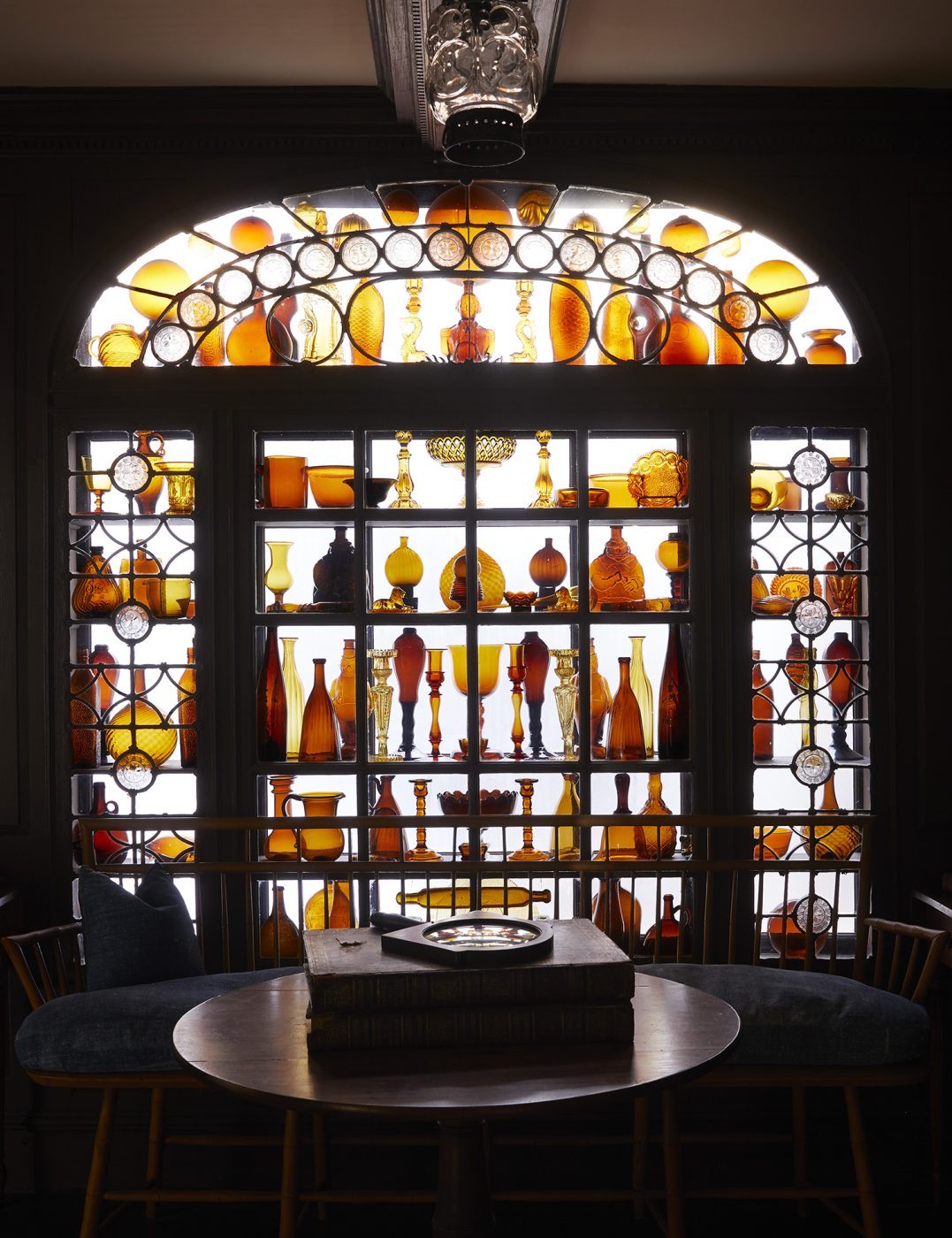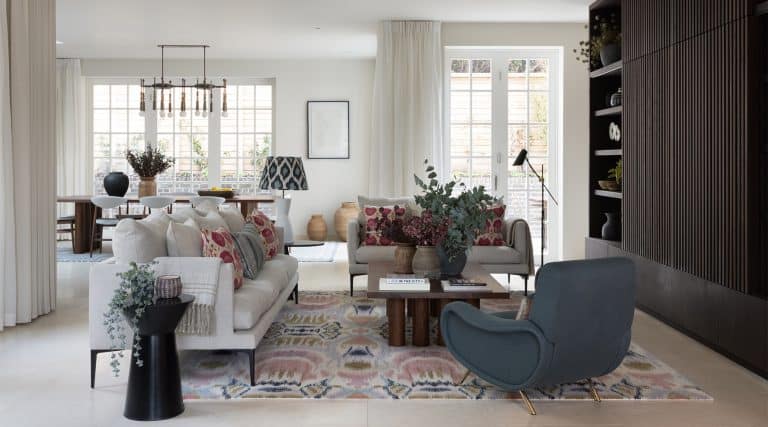August 11, 2024The bachelor pad looms large in the popular imagination as a lair for seducing women. But the first such residences had little to do with the sort of pleasure dens found in the pages of Playboy. Turn back the clock and you’ll meet a single man invested in a more aesthetic kind of bliss: the 19th-century bachelor decorator.
At a time when most straight men (and some closeted gay ones) married at the earliest opportunity, “bachelor” was code for homosexual. And when it came to interior design, the 19th-century bachelor of means had a distinct advantage — he was liberated from the conventional demands that shaped a Victorian home, namely those of a spouse and children.

Four unmarried men in New England and their aesthetic fixations are the focus of “The Importance of Being Furnished: Four Bachelors at Home,” a provocative exhibition on view through October at the Eustis Estate, a stunning 1878 Aesthetic Movement mansion and museum in Milton, Massachusetts.
“The implication that they were gay men was an important thread from the beginning,” says exhibition curator R. Tripp Evans, a professor of art history at Wheaton College, in the nearby town of Norton. “It’s not the primary theme but something we want understood in every one of the rooms.”
Evans, a specialist in American art, architecture and material culture, spent years poring over historical documents for the show and its accompanying book. Delving into the inner lives of these men, he paints a picture of the sometimes tortured souls behind four different historical homes, all of which are now house museums.

The residences themselves are offering tours and events related to the exhibition. Gibson House, an 1860 townhouse in Boston’s Back Bay, was home to the prolific writer and Boston Brahmin Charles Hammond Gibson Jr. (1874–1954). The Codman Estate, in Lincoln, Massachusetts, was decorated by one of the first professional American interior decorators, Ogden Codman Jr. (1863–1951), after four previous generations of Codmans had made their mark on the circa 1740 property. Beauport, the Sleeper-McCann House, is a meandering and magical Gloucester, Massachusetts, mansion, once owned by sought-after interior decorator Henry Davis Sleeper (1878–1934). Charles Pendleton House, built in 1906 at Rhode Island School of Design (RISD) to hold the art and antiques of dealer and collector Charles Leonard Pendleton (1846–1904), was modeled on the 1799 home where he had lived.
“I wanted four guys from the same region, same class and mostly the same profession,” says Evans, who lives in Providence, Rhode Island, with his husband and is an avid collector himself. What’s more, he notes, “they were all willing to break the rules.”

In their day, this meant expressing one’s personal taste rather than cloaking individuality in a monolithic style like the Colonial Revival prevalent at the time. The nonconformity embraced by these men represented the first real break from aesthetic monotony — a cultural shift, Evans explains, for which we can thank British writer and gay icon Oscar Wilde.
In 1882, a few years before writing the play The Importance of Being Earnest, Wilde set off on a lecture tour across the U.S. His most popular and influential presentation was titled “The House Beautiful.”
“We take as a sort of given now that decorating is supposed to be about expressing your individual style and taste,” says Evans. “But it was Oscar Wilde who opened the door to the idea that a home can be a temple to your aesthetic vision, as opposed to the Victorian notion that it’s about the nurturing of family life and inculcating Christian virtue.”

A subsequent explosion of novels about bachelor life promoted the view that only a wealthy unmarried man could make a home stylish and comfortable, says Evans. “There was a real misogyny to it,” he adds. “Women supposedly only knew where to keep the flour and how to clean.”
Misogyny aside, Codman, Gibson, Sleeper and Pendleton were devoted to their interiors and left an artistic legacy worth preserving and exploring. The exhibits at the Eustis Estate include carefully curated selections of furniture, decorative arts, paintings, photographs, letters and other ephemera representing the homes and their owners’ aesthetics. Here we take a look inside each of the four deeply personal, gloriously idiosyncratic bachelor pads.
The Codman Estate

One of the more influential tastemakers of early-20th-century New England, Ogden Codman Jr. coauthored the definitive guide to interior design at the time, The Decoration of Houses (1897), with his distant cousin novelist Edith Wharton. The two espoused a less-is-more elegance and return to classicism, in contrast to the nouveau riche opulence that was transforming the wealthy seaside resort of Newport, Rhode Island. Codman had redecorated Wharton’s home there in 1893 while working as an architect in Boston. Soon afterward, she introduced him to Cornelius Vanderbilt, who hired him to decorate the family quarters of the Breakers, Vanderbilt’s grandiose new Newport mansion.
The show includes Codman’s rendering for the Breakers, which is a study in balance and symmetry yet hardly restrained. It conveys the dichotomy that shaped Codman’s taste his whole life. “The overarching idea for Codman is that he was split between two poles: stalwart conservative Yankee patrician on the one side and spendthrift, expatriate, decadent French on the other,” says Evans. Codman wrote frequently to fellow architect Arthur Little about his homosexual escapades and collected homoerotic photography but also longed for the propriety, reputation and wealth suggested by his family estate in Lincoln, Massachusetts.

The estate had been a source of both pride and shame for generations, having been sold off by Codman’s grandfather in 1807 and bought back by his father in late 1862. Codman had, in fact, only spent his childhood there. After the Great Boston Fire of 1872 and a series of global financial panics bankrupted his father’s insurance business, his family rented out the estate and relocated to France, which had also drawn previous generations of Codmans.

“Codman looks back at this as the moment his family fell from grace,” says Evans. “He never goes back to live there really, but it becomes his touchstone.”
Codman returned to Boston in the early 1880s and began making trips to the estate to redecorate it, even as the renters lingered. Once they vacated, he revamped his former bedroom with William Morris textiles. His family returned to the house, and his fixation on its decor continued as his interior design career took off in New York. He eventually moved back to France but kept tweaking the Lincoln property from afar, adding Louis XVI–style furnishings, in particular.

Two chairs on display at the Eustis Estate represent the duality of Codman’s aesthetic persona. The first is a William Morris–upholstered recliner that he acquired for his bedroom, “a sign of his early allegiance to the English Arts and Crafts movement,” says Evans.
The second is an elegant Louis XVI–style armchair in a toile de Jouy fabric that was part of his redecoration of the southeast parlor. “For him, it doesn’t get better than this,” says Evans. “He re-creates that room for all these different clients in Newport.”
Gibson House

A prolific poet and novelist and eccentric man about town, Charles Hammond Gibson Jr. was nearly 60 when he inherited his childhood home, a stately four-story row house built by his grandmother in 1860 in Boston’s Back Bay, a fashionable new neighborhood at the time.
His possession of the home was unexpected. His father had disinherited him in 1916, likely because of his scandalous affair with a self-styled French count; the senior Gibson wasn’t fond of his son’s literary ambitions either.
“But when his mother died, in 1934, his sisters, who officially inherited the house, sold it to him for a buck,” says Evans.
Gibson’s mother had been the first to redecorate the house, in 1890, adding the latest Aesthetic Movement fashions — including gilded bas-relief wallpaper produced in Japan — to the Victorian furnishings.
“When Charlie moves in, he wants to change nothing, because he wants it to be a shrine to his family and this earlier period,” says Evans.
He preserved what was there and added elements in tune with his own vain, quirky sensibility, suffused with a nostalgia for his youth as a sought-after upper-crust Bostonian.
He hung prints of French châteaux and framed letters from royalty, photographs of celebrities and many of his own manuscripts.

“He only changed two rooms significantly,” says Evans, “the ones that were important to his father.” Perhaps out of spite, he transformed his father’s bedroom into a space for writing and installed three portraits of himself that he’d commissioned when he was younger above the mantel.

“He loved his own image as a young man,” says Evans. “We know from letters that he was pursued by pretty much every gay man in Boston, including Ogden Codman.”
Beauport, the Sleeper-McCann House

A sprawling, seaside, Aesthetic Movement fever dream of a house, Beauport was designed by Henry Davis Sleeper between 1907 and 1934.
In 1906, Sleeper traveled from Boston to Gloucester’s picturesque Eastern Point at the invitation of Harvard professor A. Piatt Andrew, a magnetic and handsome economist he’d met at a dinner party. Sleeper fell head over heels for Andrew, says Evans, and within a year purchased a waterfront lot as close as he could to Red Roof, the house Andrew had built in 1902.
Andrew, who had a predilection for charismatic, athletic young men, which the shy Sleeper was not, deflected his romantic overtures, but the two became close friends. Their small patrician but bohemian social circle on Eastern Point was legendary; it also included collector Isabella Stewart Gardner and painter Cecilia Beaux.
His love unrequited, Sleeper poured his passion into designing and decorating a home that might keep Andrew’s attention. “Beauport unfolds in this sprawling tribute to his neighbor,” says Evans.

Sleeper originally built the home as a 26-room Arts and Crafts stone-and-shingle getaway where he and his widowed mother could escape from Boston in the summers. Over the years, he added room after treasure-filled room, each with its own eye-catching theme — for example, the orientalist China Trade Room — or character. By the time of his death, at the age of 56 in 1934, the house had grown into a fairytale-like 46-room mansion that upended all sorts of conventions.

“Sleeper collected all these incredible eighteenth- and nineteenth-century Windsor chairs — all different profiles,” says Evans. “Because they were going into a seafoam-green room, he just painted them, which nobody else would have done.”


Color was incredibly important to Sleeper. He backlit his collection of amber glass to make it glow and filled his celebrated Octagon Room, built in 1921, with blood-red accents. “It’s the greatest love letter Sleeper ever wrote to Andrew,” says Evans, noting its nod to Red Roof.

With Beauport as a kind of model, Sleeper began decorating the homes of friends and locals. Eventually, the industrialist Henry du Pont noticed his unusual design sensibility and hired him, first to decorate du Pont’s Southampton, New York, summer home and then to advise on the redecoration of Winterthur, his estate in Delaware. Still, it’s the lovelorn beauty of Beauport where Sleeper’s legacy lies.
Charles Pendleton House

In 1904, near the end of his life, Pendleton, a Providence antiques dealer, gifted his vast collection of 18th-century furniture to RISD with the stipulation that the college build a replica of his Federal-era home to house it. RISD welcomed the deal, and the displays that were created over the next few years became the first period rooms in an American museum.
But Pendleton, it turned out, was full of surprises.
After his death, it was discovered that he had amassed vast gambling debts; the Metcalf family, who founded RISD, stepped in to pay them and rescue his possessions from creditors. Furthermore, while conducting his research, Evans determined that Pendleton never actually owned the home he asked RISD to replicate but only rented it. Pendleton did, however, decorate it with quite a bit of artistic flair, much of which was lost in RISD’s translation, according to Evans.
“When people talk about Pendleton House, they say, ‘It is a house that a nineteenth-century gentleman of taste and means would have lived in a century and a half ago,’ ” Evans observes. But Pendleton was far from your typical gentleman collector. “Most people would have one tall case clock, one secretary, one mirror. He had five clocks, five secretary bookcases, fourteen mirrors. And then, there is his obsessive collecting of ceramics, which he stuffed into these secretaries and never used.”

Pendleton loved English furniture, particularly Chippendale, which in turn-of-the-century New England, was considered too showy, with its sheen and curves, and, Evans explains, “more appropriate for a gambling den than a home.” Pendleton valued beauty above authenticity or provenance and bought all kinds of objects from all over the world.

RISD preferred to focus on the Colonial American items. Into storage went most of the Chippendale pieces, the Turkish rugs, the Chinese ceramics, the Dutch paintings and quite a bit of 18th-century English Whieldon pottery.
Evans aims to reveal what an eccentric figure Pendleton actually was. “We know very little about him, but we do know that he was expelled from Yale and that he was a huge gambler and gained and lost tons of money,” says Evans. “And we know that he was a big decorative arts dealer and didn’t just handle antiques.”

If Pendleton wasn’t a decorator, exactly, or explicitly gay for that matter — all that’s known about him is that he remained unmarried — his inclusion rounds out the show and helps demonstrate how willing these men were to veer from the norm. “In some places, like Newport, all the interiors looked the same,” says Evans. “But for these bachelors, it was really choose your own aesthetic path.”







